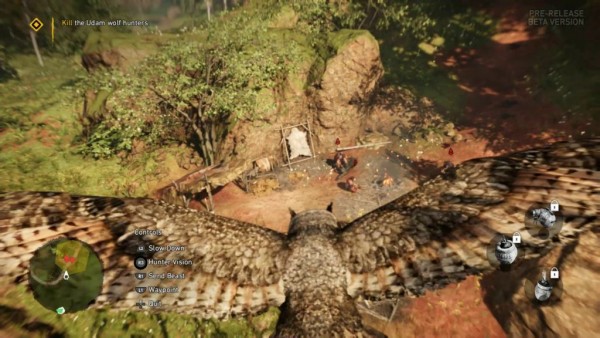 Entering Ubisoft?s San Francisco offices on a rainy Tuesday morning to play Far Cry Primal, I could only think one thing: who thought shuffling a large open-world first person shooter into the Mesolithic Era with cavemen was a good idea? It?s absurd, confusing, and has a lot of chance to wander into goofy, abject failure.
Entering Ubisoft?s San Francisco offices on a rainy Tuesday morning to play Far Cry Primal, I could only think one thing: who thought shuffling a large open-world first person shooter into the Mesolithic Era with cavemen was a good idea? It?s absurd, confusing, and has a lot of chance to wander into goofy, abject failure.
From minutes one to two hundred of forty of playing the game, that awful turn never came. Instead, Far Cry Primal takes the concept and runs with it in a cold open featuring hunting, stealth, and finding an enemy tougher than you in a sabretooth tiger. A few minutes later, our stoic lead in Takkar of the Wenja Tribe is painfully alone. His hunting team is dead. He lives. And he has to rebuild.
As you may assume, keeping things stocked early is a Bit of a Hassle. Constant grabbing of resources, hunting, healing, and crafting while trying not to get killed by anything deadlier than you (read: a lot of things) takes Time. A few missions of earning story characters, establishing outposts, and finding fellow tribesmen later, resources start to trickle in on a regular basis. Suddenly, making a full complement of arrows goes from being an obligation to somewhat plentiful.
Of course, this is the point at which the game decides to expand past pure survival. Two rival tribes in the more primitive Udam and the more advanced Izila start threatening not only your movement in the real world?but also your home. All three tribes have their own quirks: the Wenja deal with nature in a shamanic relation, the Izila are more spiritual and handle fire, and the Udam are simple-minded brutes who practice cannibalism.
Adding to the lore are the tribal languages, a part of the game that?s so familiar?yet so foreign?it helps bring a surprising level of immersion to the game. After attempts with using English ?weird,? and broken English ?even weirder,? Creative Director Jean-Cristophe Guyot noted the team looked to Proto-Indo-European (PIE) language. While PIE is a far more modern language (circa 3,500 BC), its primitive and mostly-obscure-outside-academia nature and the fact it forms the roots for a vast majority of languages make it an ideal fit for the game. Slight tweaks for the Udam to dumb it down a bit, or advancements with the Izilia in Middle-Eastern throat-noises establish distinct, character-building divergent languages.
Specific to the shamanic nature of the Wenja, Far Cry Primal gives the opportunity to tame and command a wide variety of animals. Early gameplay afforded two: an owl and a wolf. As the first animal, the owl will probably be the most-used. Its default abilities revolve around recon, but its skill tree affords some minor attacks and distraction. Wolves, on the other hand, are better for being a precursor to a larger attack. Creature companions can and do need to be healed on occasion, as if they die another must be tamed.
Far Cry Primal brings together a lot of weird ideas: a focus on first-person melee, serious caveman storylines, animal friends, bug-eyed hallucinating shamans telling you to talk to glowing owls. Somehow, for at least the first four hours, it comes together really well.


